SUPERCHARGE YOUR ONLINE VISIBILITY! CONTACT US AND LET’S ACHIEVE EXCELLENCE TOGETHER!
The project titled “Vector-Based Search Retrieval: Uses vector representations to match queries with results beyond keyword matching” implements an advanced semantic search system designed to enhance information retrieval across webpages. Traditional keyword-based search often fails to capture the true intent behind user queries, leading to irrelevant or partial results. This solution addresses that limitation by transforming both user queries and webpage content into high-dimensional vector embeddings, enabling highly relevant matches based on semantic meaning rather than mere word overlap.

By utilizing Sentence-BERT embeddings and FAISS (Facebook AI Similarity Search) for fast nearest-neighbor search, this system performs deep matching between user queries and content. It is capable of accurately retrieving the most contextually relevant sentences from web pages, regardless of vocabulary variations or phrasing mismatches.
The system is implemented with scalability, interpretability, and client-facing application in mind. It supports batch processing of multiple URLs and queries, delivers ranked search results for each match, and exports the final output to a structured CSV format—ready for integration with content strategy, SEO workflows, or user experience enhancement tools.
Project Purpose
The primary purpose of this project is to build a semantic search and content matching framework that surpasses the limitations of traditional search approaches. Instead of relying on keyword frequency or exact matches, the system understands the meaning behind a query and finds semantically similar content, even if the wording is entirely different.
This capability is particularly important for:
- Enhancing content discovery on knowledge bases, blogs, and documentation pages.
- Reducing bounce rates by guiding users to contextually relevant information.
- Improving internal linking structures based on semantic topic similarity.
- Generating featured snippets or candidate answers from existing content.
- Informing content gap analysis and identifying under-served queries.
The system processes each URL independently, cleans and filters its text, converts the cleaned sentences into dense vector embeddings, and indexes them using a FAISS similarity search engine. When provided with natural language queries, the system retrieves and ranks the most semantically relevant content snippets from each page.
This approach ensures that search results are not just technically matching, but contextually aligned with user intent, thereby significantly improving search relevance and content performance.
Explanation of Key Concepts in Vector-Based Search Retrieval
To fully appreciate the functionality and impact of the system, it is essential to understand the foundational concepts that power the solution. The term “Vector-Based Search Retrieval” encapsulates several advanced yet intuitive ideas that underpin the way modern semantic search engines operate. This section provides a detailed explanation of each term, broken down into the following subsections:
Vectors
In natural language processing (NLP), a vector is a list of numbers that captures the semantic information of a piece of text — such as a sentence or a paragraph. This numerical form is created by models like Sentence-BERT, which have been trained on large corpora to understand the underlying meaning of words and phrases, even when phrased differently.
For example, the sentences:
- “How to reduce bounce rate?”
- “Ways to lower website exits.”
may contain completely different words, but their vector representations will be close in multidimensional space if they carry similar meaning.
Each vector lives in a high-dimensional space — often with 768 dimensions or more — where the distance between two vectors reflects how semantically similar they are. The closer the vectors, the more similar the meanings.
Vector Search
Once content and queries are converted into vectors, they can be searched and compared mathematically. This is where vector search becomes critical.
Unlike traditional keyword search engines that look for exact or partial matches between query words and document text, vector search computes distances (or similarities) between query vectors and content vectors. If two vectors are very close, it indicates strong semantic similarity, even if there are no overlapping words.
This project uses FAISS (Facebook AI Similarity Search), an industry-grade library optimized for performing fast vector similarity searches at scale. FAISS allows finding the top-N most similar content snippets for any given query in milliseconds, making the approach suitable for real-time or high-volume applications.
The similarity is computed using cosine similarity, which measures the angle between two vectors. The smaller the angle (i.e., the more aligned the meanings), the higher the similarity score.
Retrieval
Retrieval refers to the process of selecting and returning the most relevant information from a larger dataset. In this context, it means:
- Searching a web page’s content for the most semantically relevant sentences based on a query.
- Ranking those sentences by their similarity scores.
- Returning the top results that best answer or match the query intent.
This retrieval is intelligent and meaning-based, not rule-based or keyword-focused. It allows users to find answers that are expressed differently than the query but still address the same concept.
For instance, if a user searches “how to handle document URLs,” the system might retrieve a sentence such as:
- “HTTP headers are useful for serving different document types from the same URL.”
This result would be difficult to match using keyword-based systems but is semantically aligned and highly relevant using vector retrieval.
Summary
Combining these three ideas — vectors, vector search, and retrieval — results in a system capable of understanding and retrieving information based on meaning, not just matching text. This leads to more accurate, useful, and context-aware content discovery, which is critical for enhancing digital experiences, SEO strategy, and overall user engagement.
What benefit does this project offer for SEO optimization?
This project directly supports multiple facets of modern SEO strategy by moving beyond surface-level keyword matches and into semantic intent recognition. Search engines increasingly prioritize content that closely aligns with user intent, even if the wording differs. By leveraging vector-based representations, this system ensures that internal content surfaces in response to varied phrasings of search queries. As a result:
- High-quality, intent-matching content is made more discoverable, leading to better engagement metrics.
- Internal link structures can be strengthened by automatically connecting semantically relevant content, which aids both user navigation and search engine crawling.
- The system enables identification and promotion of existing content as featured snippets, improving visibility in SERP (Search Engine Results Pages).
- Insights gained from low-match queries can inform future content creation, ensuring ongoing SEO competitiveness.
What is the primary business value this project delivers?
This project transforms static website content into a dynamic, query-responsive system that intelligently matches user intent with existing materials. By utilizing vector-based retrieval, it enables highly relevant content suggestions that are contextually aligned with real search queries. This directly supports key business goals such as improving content discoverability, increasing session time, guiding user navigation, and unlocking deeper SEO value from existing content assets.
What makes this useful for content teams?
Content teams can use the output to understand which parts of the website are addressing specific search intents and which are not. This helps identify content strengths, uncover outdated or weak areas, and inform decisions about internal linking, updating existing content, or creating new pages. The system acts as a semantic audit tool, aligning the content library with actual user needs.
What problem does this solve that traditional keyword search cannot?
Traditional keyword search relies on exact term matching, often missing relevant content that uses different phrasing or terminology. This project solves that limitation by using semantic vector embeddings, which allow it to understand the meaning behind a query and surface content that is topically related—even if the exact keywords don’t appear. As a result, users find more accurate answers, even for complex or long-form queries.

requests
Used to send HTTP requests and retrieve the raw HTML content of a given webpage. It serves as the initial data acquisition layer, forming the foundation for further processing.
· Purpose: Page fetching and HTML retrieval.
· Importance: Enables the system to dynamically collect content from live web URLs without manual copying.
BeautifulSoup (from bs4)
A web scraping tool used to parse HTML documents and extract specific elements such as paragraph tags, headings, and list items.
· Purpose: Clean extraction of visible and meaningful content from web pages.
· Importance: Removes unnecessary HTML noise, enabling structured and consistent sentence-level input for the embedding model.
csv
Used to export the final results into a CSV file format, which can be easily read by non-technical stakeholders or imported into spreadsheet tools for analysis.
· Purpose: Data export and sharing.
· Importance: Facilitates delivery of actionable outputs in a business-friendly format.
re (Regular Expressions)
Handles text cleaning and pattern-based filtering of noisy content such as broken formatting, HTML leftovers, or non-informative symbols.
· Purpose: Preprocessing and text normalization.
· Importance: Enhances the quality of input data before semantic analysis, improving model accuracy.
nltk (Natural Language Toolkit)
Specifically uses sent_tokenize from nltk.tokenize to segment content into meaningful individual sentences.
· Purpose: Sentence-level tokenization of long-form content.
· Importance: Embedding and retrieval operate at the sentence level, requiring precise and context-aware splitting of content.
· Note: nltk.download(‘punkt’) is required to enable sentence tokenization by downloading the pretrained model for English.
numpy
Used to handle numerical operations such as computing similarity scores between query and content embeddings.
· Purpose: Vector arithmetic and score computation.
· Importance: Ensures fast and reliable computation when processing and ranking semantic similarity results.
sentence-transformers (Sentence-BERT)
Provides the backbone semantic embedding model (all-mpnet-base-v2) used to convert both user queries and webpage sentences into dense vector representations.
· Purpose: Semantic encoding of content and queries.
· Importance: Enables the project to understand meaning beyond keywords by comparing sentences in a high-dimensional vector space.
This model is optimized for capturing semantic similarity, making it well-suited for content matching and retrieval tasks.
faiss (Facebook AI Similarity Search)
A highly efficient library for vector similarity search. It indexes and retrieves the most semantically similar content vectors to any given query vector.
· Purpose: Fast and scalable nearest-neighbor search in embedding space.
· Importance: Ensures high-speed and accurate retrieval of the top content results, even when dealing with large volumes of content.
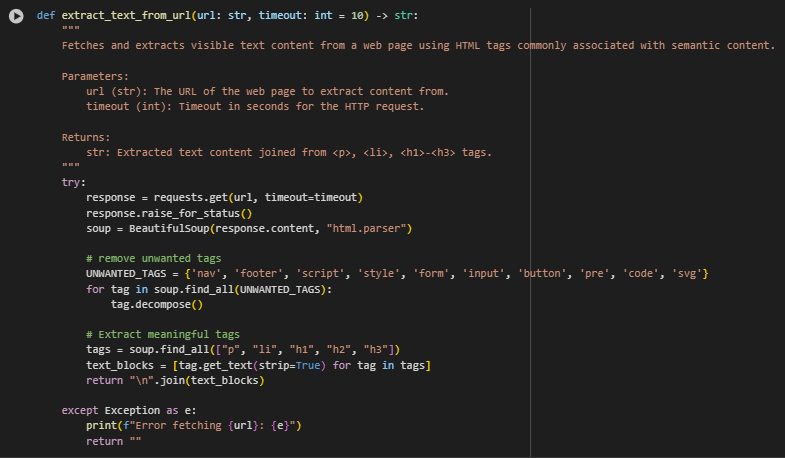

Function Overview: extract_text_from_url – Web Content Extraction
The function extract_text_from_url is responsible for retrieving and isolating the visible, meaningful content from a web page. It acts as the foundation of the entire semantic search pipeline by collecting raw content that will later be transformed into semantic vectors. The function selectively targets semantic HTML tags such as <p>, <li>, and <h1>–<h3>, which are commonly used to express primary information on a webpage.
By filtering out irrelevant or structural components such as navigation bars, scripts, or forms, the function ensures that only high-value text is passed forward for semantic embedding. This enhances retrieval accuracy and avoids polluting the vector space with noise.
Step-by-Step Explanation
response = requests.get(url, timeout=timeout)
- Sends an HTTP GET request to fetch the content from the provided URL.
- Retrieves the raw HTML content of the target web page. A timeout is specified to avoid long delays in case of unreachable pages.
soup = BeautifulSoup(response.content, “html.parser”)
- Parses the fetched HTML content using BeautifulSoup’s HTML parser.
- Converts the HTML string into a searchable tree structure, enabling extraction of specific elements.
UNWANTED_TAGS = {‘nav’, ‘footer’, ‘script’, ‘style’, ‘form’, ‘input’, ‘button’, ‘pre’, ‘code’, ‘svg’}
- Defines a list of non-content tags that typically contain code, UI elements, or layout structures.
- These tags are removed to avoid irrelevant or misleading content being processed.
for tag in soup.find_all(UNWANTED_TAGS): tag.decompose()
- Iterates through all unwanted tags found in the document and removes them from the soup object.
- Cleans the HTML structure and ensures that only meaningful content remains for extraction.
tags = soup.find_all([“p”, “li”, “h1”, “h2”, “h3”])
- Selects HTML elements known for containing primary readable content—paragraphs, list items, and major headings.
- Narrows focus to only those components that hold substantive information, increasing the signal-to-noise ratio.
text_blocks = [tag.get_text(strip=True) for tag in tags]
- Extracts plain text from each tag and removes extra whitespace.
- Converts HTML tag content into clean text blocks suitable for further processing.
return “\n”.join(text_blocks)
- Combines all extracted text blocks into a single string separated by newlines.
- Outputs structured, readable content that serves as the input for semantic sentence tokenization.
except Exception as e: …
- Handles connection errors, invalid URLs, or HTML parsing issues.
- Prevents the system from crashing when a URL fails and logs the error for debugging or retry logic.
This function is crucial for enabling vector-based semantic analysis as it guarantees that only relevant textual data is passed into downstream processing stages such as sentence tokenization, embedding, and search retrieval.
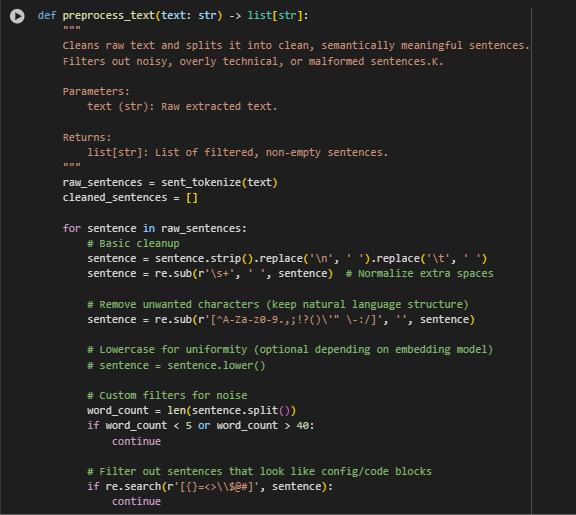

Function Overview: preprocess_text – Text Preprocessing and Sentence Filtering
Summary
The preprocess_text function plays a pivotal role in transforming raw, extracted website text into a clean and usable list of individual sentences. This step occurs before converting textual content into vector representations. The function eliminates malformed content, excessive punctuation, overly short or long text, and code-like noise to ensure that only high-quality, semantically meaningful sentences are preserved.
Such preprocessing is critical in vector-based search systems to avoid diluting the semantic search space with noisy data and to improve the relevance of content retrieved in response to a user query.
Step-by_step Explanation
raw_sentences = sent_tokenize(text)
- Breaks the raw multi-paragraph text into individual sentence units.
- Enables fine-grained semantic comparison by treating each sentence as an atomic unit for embedding.
sentence = sentence.strip().replace(‘\n’, ‘ ‘).replace(‘\t’, ‘ ‘)
- Strips whitespace and replaces line/tab breaks with single spaces.
- Normalizes sentence formatting to prevent splitting errors in embedding or display inconsistencies.
sentence = re.sub(r’\s+’, ‘ ‘, sentence)
- Collapses multiple spaces into a single space.
- Prevents irregular gaps that could mislead tokenization or vectorization.
sentence = re.sub(r'[^A-Za-z0-9.,;!?()\'” \-:/]’, ”, sentence)
- Removes all non-standard characters while retaining essential sentence punctuation and structure.
- Ensures sentence embeddings focus on natural language, not technical or non-linguistic symbols.
word_count = len(sentence.split())
- Counts the number of words in each sentence.
- Used to apply filtering thresholds that control sentence length.
if word_count < 5 or word_count > 40: continue
- Discards sentences that are too short or too long to be meaningful or well-formed.
- Very short sentences often lack context, while very long ones are likely lists, descriptions, or run-on text—both can reduce relevance in semantic matching.
if re.search(r'[{}=<>\\$@#]’, sentence): continue
- Filters out sentences that contain symbols indicative of code, configuration files, or templates.
- Helps maintain a clean, natural language corpus that aligns with human-readable content, not machine instructions.
if (‘http’ in sentence and ‘;’ in sentence and word_count > 20): continue
- Removes complex, malformed links or embedded scripts that appear as large sentence-like blocks.
- Prevents broken or non-informative strings from affecting semantic accuracy.
cleaned_sentences.append(sentence)
- Adds the cleaned and validated sentence to the result list.
- Builds the final output of high-quality sentences to be converted into semantic vectors.
This preprocessing function ensures that only human-readable, structurally valid, and semantically useful sentences are selected for downstream embedding. By removing irrelevant or malformed content early in the pipeline, it enhances both the efficiency and quality of vector-based retrieval.
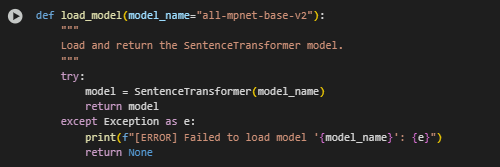
Function Overview: load_model – SentenceTransformer Model Loading
Summary
The load_model function is responsible for initializing the Sentence-BERT model used for generating dense vector representations of text. Sentence-BERT, particularly the variant all-mpnet-base-v2, is a state-of-the-art model fine-tuned for semantic similarity tasks. This model is essential for transforming both content and search queries into numerical vectors that enable semantic matching in the retrieval system.
By abstracting the model loading into a standalone function, the code allows for easy customization, reuse, and error handling.
Step-by_step Explanation
model = SentenceTransformer(model_name)
- Loads the specified Sentence-BERT model from the Hugging Face Model Hub.
- This is the critical step that brings in the pretrained model architecture and weights necessary for semantic vectorization. The chosen model, all-mpnet-base-v2, is highly optimized for semantic similarity, making it well-suited for retrieval tasks.
This function encapsulates the model initialization logic in a reusable and robust format, enabling seamless updates or substitutions of the embedding model. It ensures the semantic core of the system is reliably prepared before starting content processing or retrieval tasks.
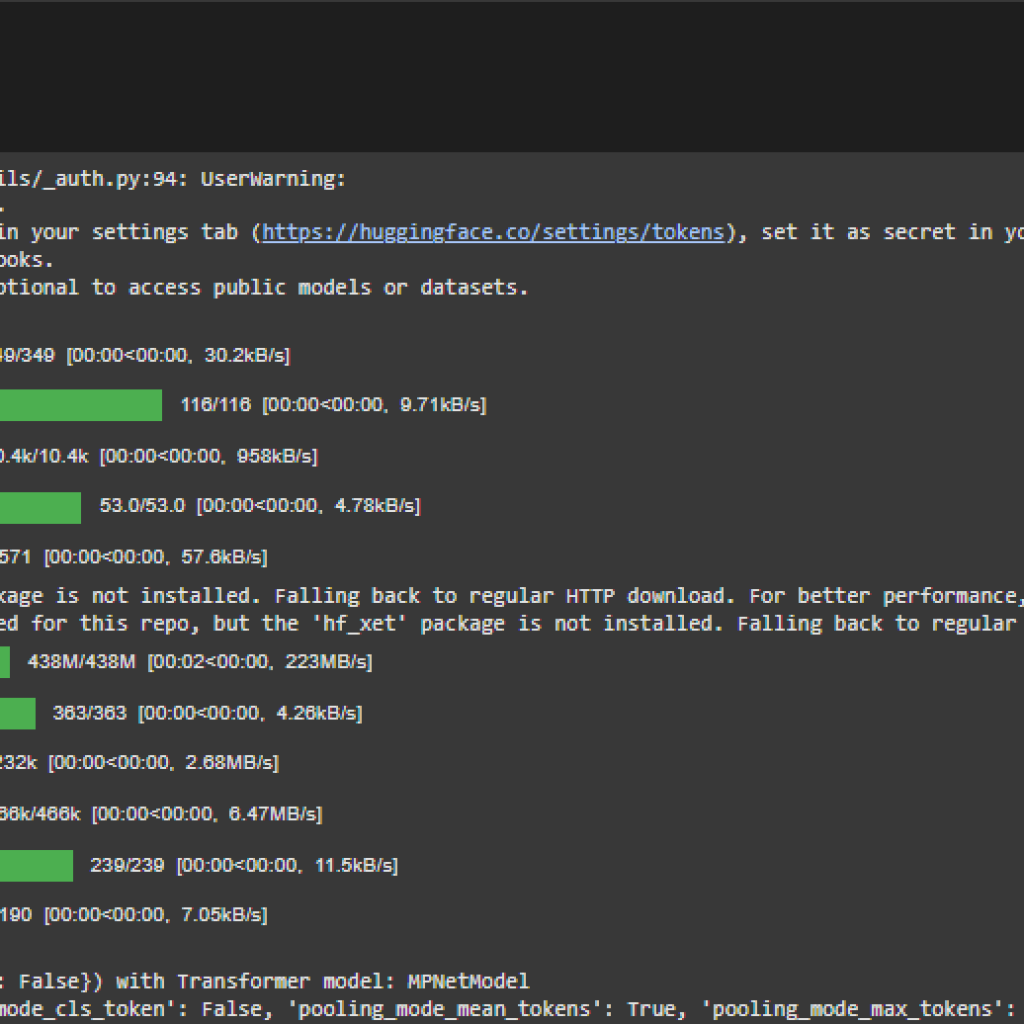
Model Explanation — Sentence-BERT with MPNet
This project leverages Sentence-BERT with the MPNet transformer to power its vector-based semantic search functionality. The model is responsible for converting both website content and user queries into high-quality vector representations, enabling precise semantic matching beyond simple keyword overlap.
What Is Sentence-BERT?
Sentence-BERT (SBERT) is an adaptation of BERT, a state-of-the-art language model developed by Google. While BERT was originally designed for token-level tasks (like predicting the next word), Sentence-BERT restructures it to work efficiently at the sentence level.
This adaptation is crucial for tasks like semantic search, where entire sentences or paragraphs need to be compared for meaning, not just individual words.
Unlike traditional BERT, which is computationally expensive for pairwise comparisons, Sentence-BERT enables fast, scalable comparisons by generating fixed-length vector embeddings for sentences. These vectors can be stored, indexed, and compared using efficient algorithms — exactly what’s needed for a high-performing search retrieval system.
Architecture Used in This Project
The specific model used is all-mpnet-base-v2, a fine-tuned Sentence-BERT variant that combines SBERT with MPNet, one of the most effective transformer models in the domain of sentence similarity.
The internal structure of the model includes:
· Transformer Encoder (MPNet)
This is the core of the model. It reads sentences and builds context-aware representations for each word by analyzing the sentence structure. MPNet stands out for its ability to capture both global meaning and fine-grained relationships between words.
· Pooling Layer (Mean Pooling)
After processing the sentence, the model averages the output vectors of all words to produce a single embedding vector. This vector captures the overall meaning of the sentence in a format that can be mathematically compared to other vectors.
· Normalization Layer
The final step is normalization. All sentence vectors are adjusted to have the same scale (length), which ensures that similarity scores are meaningful and consistent across comparisons.
These components work together to convert any sentence or search query into a 768-dimensional vector — a compact numerical representation of meaning.
Why This Model Was Chosen
The model offers a number of advantages for semantic search applications:
· High Semantic Accuracy
It captures deep contextual meaning, allowing the system to retrieve content that matches the intent behind a user’s query, not just the exact words used.
· Scalability for Real-Time Use
Since each sentence is pre-encoded into a vector, there is no need to recompute embeddings during search, making it well-suited for handling large volumes of content efficiently.
· Compatibility with FAISS Indexing
These vectors integrate seamlessly with the FAISS indexing system used in this project, enabling rapid similarity searches across tens of thousands of entries.
· Well-Validated Performance
The model is trained and validated on multiple benchmarks in natural language understanding, offering robust performance out of the box.
Role in This Project
In this project, the model serves a central role:
- Transforms all sentences from a website into vector embeddings.
- Encodes incoming user queries in the same vector space.
- Enables Retrieval by comparing the query vector to all content vectors and ranking them by semantic closeness.
By doing so, it powers a system that connects users directly to the most relevant content on a website — even when exact keywords don’t match — resulting in better content discovery and improved user satisfaction.



Function Overview: encode_sentences — Sentence Encoding
Summary
This function is responsible for converting plain English sentences into numerical vector embeddings using the previously loaded Sentence-BERT model. These embeddings are the foundation of the project’s semantic search capabilities, allowing for accurate and efficient comparison between user queries and website content.
The purpose of this function is to:
- Take a list of cleaned sentences (usually extracted from a web page).
- Encode each sentence into a 768-dimensional vector using Sentence-BERT.
- Normalize the vectors so that they can be compared using cosine similarity or inner product measures.
- Return the complete matrix of sentence embeddings for downstream indexing and retrieval.
This encoding step ensures that semantic similarity — not just word overlap — can be used to retrieve matching content.
Step-by-Step Explanation
embeddings = model.encode(sentences, convert_to_numpy=True, normalize_embeddings=True)
- model.encode(…) This method uses the Sentence-BERT model to compute embeddings for each input sentence.
- convert_to_numpy=True Converts the output into a NumPy array, making it compatible with mathematical operations and the FAISS search index.
- normalize_embeddings=True Ensures that each embedding is scaled to unit length. This is important for consistent and reliable similarity scores when comparing vectors during retrieval.
The final result is a structured array where each row corresponds to a sentence, and each column represents a numerical dimension in the model’s semantic space.
Output Shape: (number_of_sentences, 768)
Use Case: This matrix is later used to build a FAISS index for fast, real-time vector-based search.
This function effectively transforms raw textual data into a search-ready representation, bridging the gap between language and computation.
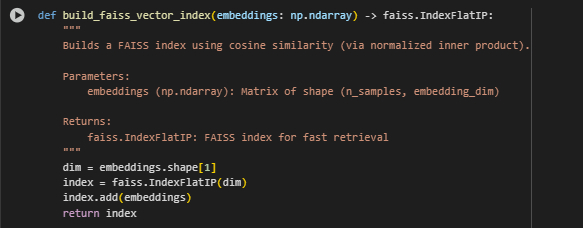
Function Overview: build_faiss_vector_index — Building the FAISS Vector Index
Summary
This function is designed to create a fast and efficient vector search index from the sentence embeddings. The index enables rapid similarity searches that power the vector-based retrieval system.
The key objectives are to:
- Accept a matrix of normalized vector embeddings representing the content sentences.
- Build a FAISS index to perform approximate nearest neighbor search using cosine similarity.
- Return the configured index object for later querying with user search vectors.
FAISS (Facebook AI Similarity Search) is a widely used open-source library optimized for high-speed similarity search at scale.
Step-by-Step Explanation
dim = embeddings.shape[1]
- Retrieves the dimensionality of each embedding vector (usually 768 for Sentence-BERT).
- This dimension size is required to initialize the FAISS index correctly.
index = faiss.IndexFlatIP(dim)
- Creates a Flat Index using Inner Product (IP) as the similarity metric.
- Since embeddings are normalized, the inner product effectively computes cosine similarity, which is a standard measure for comparing semantic vectors.
- The “Flat” index means it stores all vectors without compression, ensuring exact search results but using more memory.
index.add(embeddings)
- Adds all sentence embeddings into the index, making them searchable.
- This step prepares the data structure for fast query lookups.
Output:
- A FAISS index object configured for fast inner product (cosine similarity) search.
- This index can be queried repeatedly to find the most relevant sentences for any input query embedding.
Why This Step Matters
Building the FAISS index is critical for achieving:
- Scalability: Efficiently handles large volumes of content vectors without sacrificing search speed.
- Real-time performance: Enables instant semantic search responses suitable for interactive user applications.
- Accuracy: Using normalized embeddings and inner product ensures meaningful semantic similarity scores.
Without this indexing layer, the system would need to perform costly pairwise comparisons across all content vectors, making it impractical for real-world use.
This function serves as the backbone of the vector-based retrieval engine, providing the infrastructure for seamless and intelligent content discovery.

Understanding FAISS
Introduction to FAISS
FAISS, short for Facebook AI Similarity Search, is an open-source library developed by Facebook AI Research designed specifically for efficient similarity search and clustering of dense vectors. It plays a pivotal role in vector-based search systems by enabling rapid and scalable retrieval of the most semantically relevant content based on vector representations.
Why FAISS is Essential in Vector-Based Search Retrieval
In vector-based search retrieval, the core challenge is to find the closest matches in a high-dimensional space where each document or sentence is represented as a vector. As datasets grow larger, performing brute-force comparisons between a query vector and all stored vectors becomes computationally expensive and slow.
FAISS addresses this problem by:
- Accelerating nearest neighbor search, drastically reducing query response times.
- Supporting large-scale datasets with millions to billions of vectors.
- Providing multiple indexing strategies balancing speed, memory, and accuracy.
This capability makes FAISS ideal for powering real-time semantic search applications where user queries must be matched efficiently against vast content repositories.
How FAISS Works
Vector Space and Similarity Metrics
- FAISS operates on vectors embedded in a multi-dimensional space.
- Each vector represents semantic information from text, images, or other data modalities.
- Similarity between vectors is typically measured using distance metrics such as Euclidean distance or cosine similarity.
- Cosine similarity is often computed via normalized inner product for efficiency.
Index Types
FAISS supports various index types optimized for different trade-offs:
- Flat (Brute-force) Index: Stores all vectors and compares them directly; guarantees exact nearest neighbors but is slower on large datasets.
- Inverted File (IVF) Index: Partitions vectors into clusters to speed up search.
- HNSW (Hierarchical Navigable Small World) Graph: Graph-based approximate nearest neighbor search optimized for speed.
- PQ (Product Quantization) and other compression techniques: Reduce memory footprint for very large datasets.
The choice of index depends on dataset size, accuracy requirements, and hardware constraints.
Normalization for Cosine Similarity
- When vectors are normalized to unit length, inner product similarity is equivalent to cosine similarity.
- This property allows FAISS to use fast inner product calculations while maintaining semantic relevance.
Implementation in the Project
Use of IndexFlatIP
- The project utilizes the IndexFlatIP, a flat index based on inner product similarity.
- This index is straightforward and suitable for moderate dataset sizes where exact nearest neighbor retrieval is desired.
- Since the sentence embeddings are normalized, inner product corresponds to cosine similarity, a preferred measure for semantic similarity in NLP.
Building and Querying
- The index is built once by adding all sentence embeddings derived from the source content.
- During search, a query vector (derived from the user input) is compared against this index to retrieve the most semantically similar sentences.
- This retrieval supports downstream features like internal linking, content discovery, and snippet generation.
Advantages of Using FAISS
- Speed: Performs vector similarity search orders of magnitude faster than naive methods.
- Scalability: Can handle millions of vectors efficiently.
- Flexibility: Supports different metrics and index types suitable for various use cases.
- Community and Support: Maintained by Facebook AI with strong documentation and active updates.
Limitations and Considerations
- Memory Usage: Flat indices store all vectors and can consume significant memory.
- Approximate Methods Needed for Large Scale: For very large datasets, approximate indexing methods may be required, which trade slight accuracy for speed.
- Requires Vector Normalization: Proper preprocessing and normalization of vectors are critical for meaningful results.
Summary
FAISS is the fundamental technology enabling this project’s core functionality: fast, scalable, and accurate semantic search over textual content. Its implementation provides a powerful foundation for delivering enhanced user experiences through vector-based retrieval, distinguishing this system from traditional keyword matching approaches.
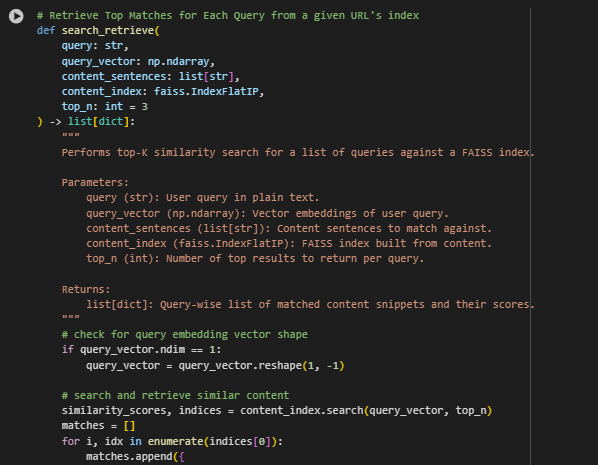

Function Overview: search_retrieve
This function takes a user’s query, transforms it into its vector representation, and efficiently searches through the pre-built FAISS vector index of content sentences to return the top matches based on similarity scores. This process enables the system to retrieve information beyond simple keyword matching by leveraging semantic understanding.
Explanation
Similarity Search:
similarity_scores, indices = content_index.search(query_vector, top_n)
Using the FAISS index, the function performs a top-k similarity search to find the content sentences most similar to the query vector. The similarity metric is cosine similarity via normalized inner product.
Result Construction:
The function collects the top matching sentences along with their similarity scores. Scores are rounded for better readability. Each result is structured as a dictionary containing the matched sentence and its corresponding relevance score.
Significance in the Project
- This function operationalizes the ector-based retrieval concept by converting semantic similarity into actionable ranked results.
- The top-matched sentences returned can be used for various purposes such as enhancing search interfaces, generating featured snippets, or suggesting internal links.
- The approach provides a richer, context-aware search experience, allowing users to find relevant information even if their queries do not exactly match keywords present in the content.
Summary
The search_retrieve function is the heart of the retrieval mechanism in this project, enabling the practical application of semantic vector search. By returning precise, semantically relevant content snippets quickly, it supports improved user engagement and content discoverability.

Function Overview: display_results
The display_results function formats and presents the search results in a clear and readable manner. This aids in quickly understanding the relevance and content of the top matches returned by the retrieval process.
Functionality
- Takes a list of result dictionaries, each containing a matched sentence and its similarity score.
- Prints the query and associated URL context.
- Iterates through each result, showing the similarity score alongside the matched sentence.
- Handles cases where no matching sentence is found by displaying a “No Data Found” message.
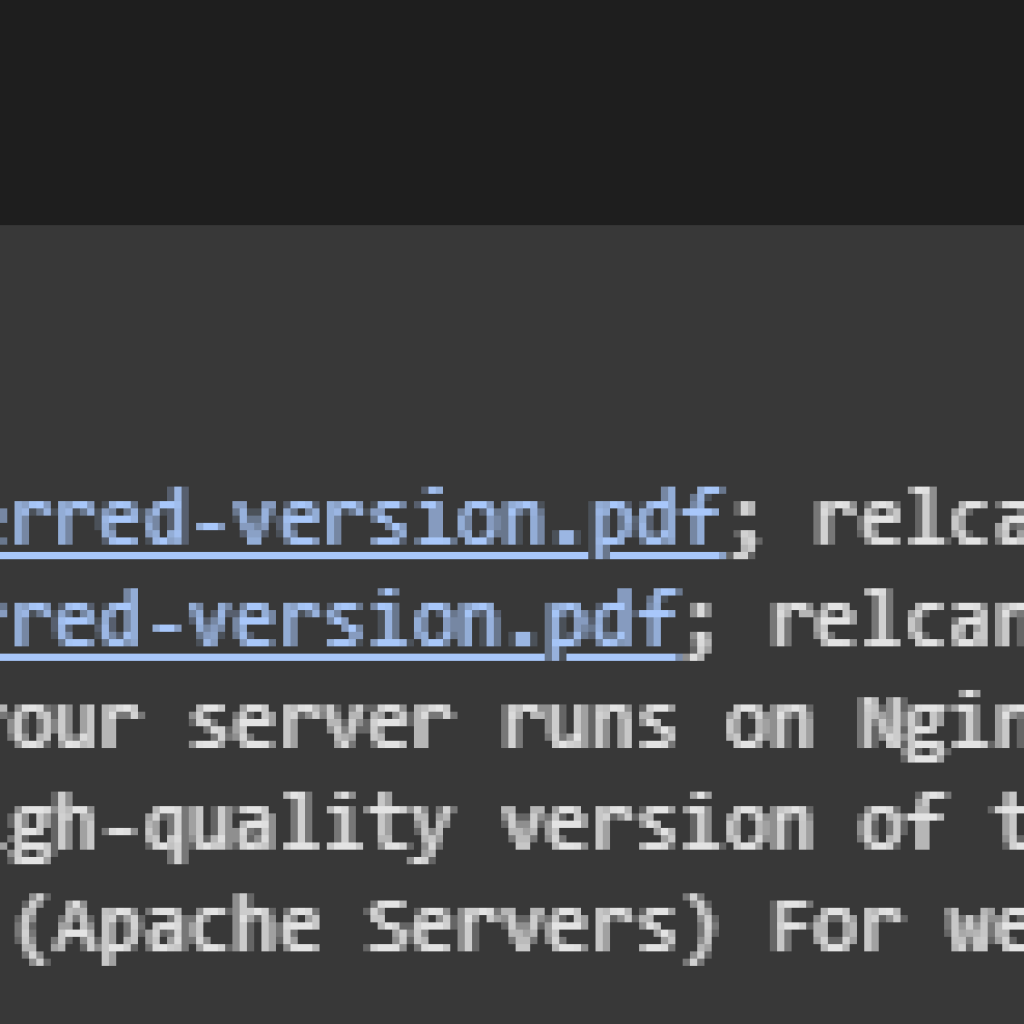
Output Analysis
The following demonstrates the retrieval results when executing a search query against the content of a single web page URL. The query used here is: “how to handle different document urls” and the target page is:
Explanation of Results
- The system returns a ranked list of sentences from the webpage that are semantically most relevant to the query.
- Each sentence is accompanied by a similarity score, which quantifies how closely the sentence’s meaning aligns with the query. Scores range between 0 and 1, with higher scores indicating stronger relevance.
- The top sentences primarily relate to handling canonical URLs and HTTP headers, which aligns well with the query about managing different document URLs.
- This confirms the system’s ability to identify and rank meaningful content beyond simple keyword matching, understanding the context and semantics of the text.
Key Takeaway
This output illustrates the project’s capability to effectively extract and rank content snippets that address the user’s intent, providing precise and contextually relevant information from a single document source.
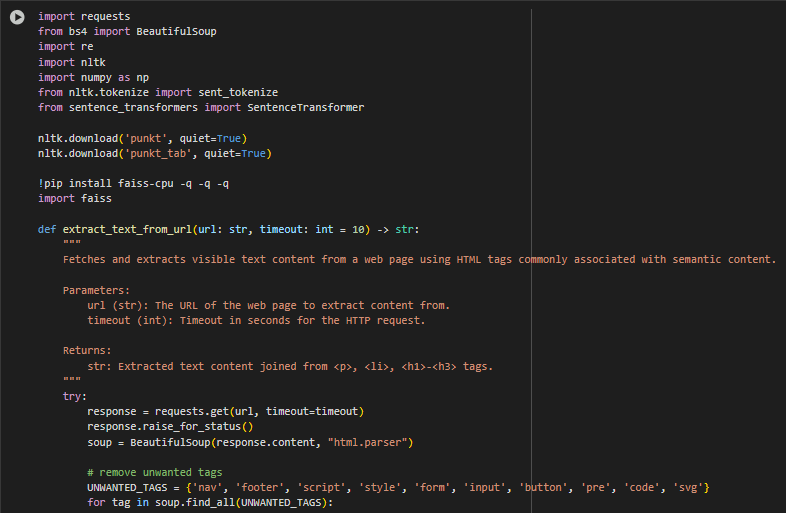
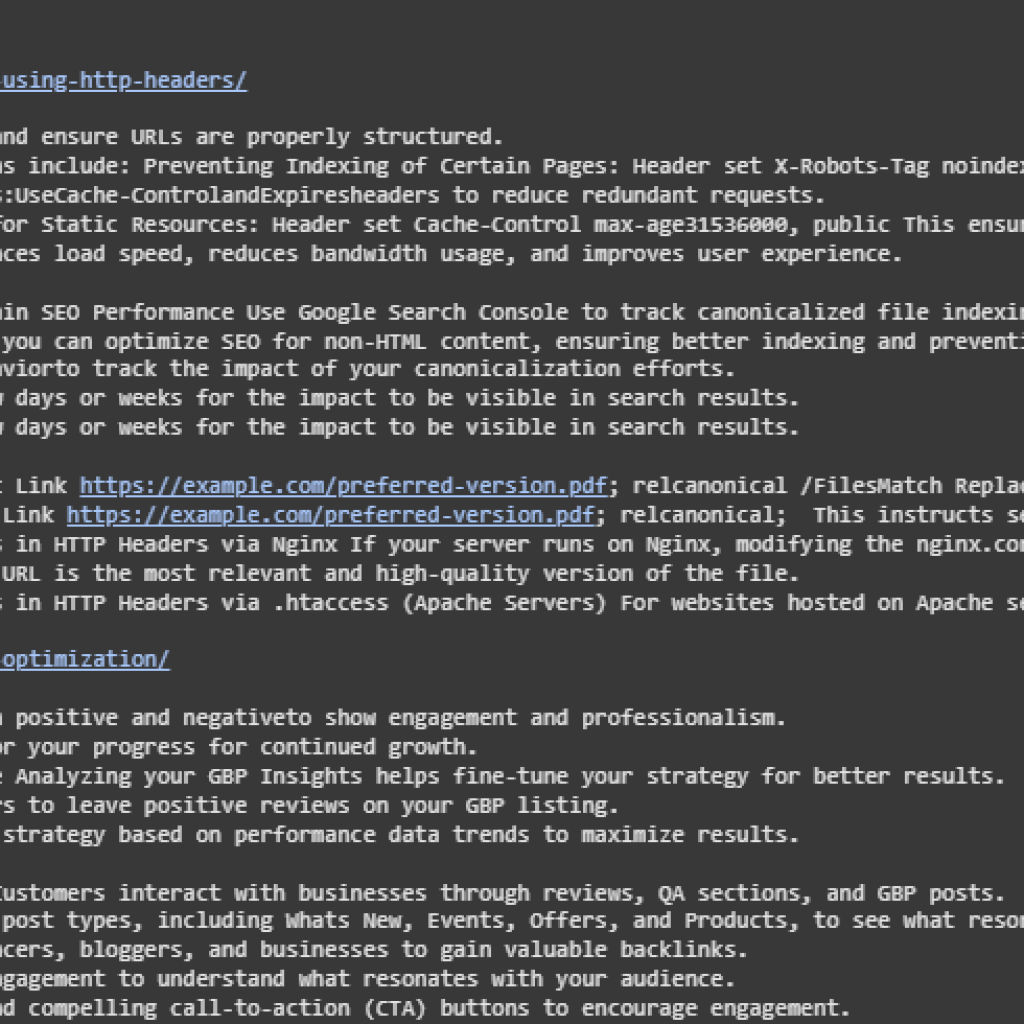
Results Interpretation and Explanation
This section provides a clear understanding of the search results generated by the semantic search system. It is designed to help interpret the output effectively and to understand how the similarity scores relate to the quality and relevance of the matches.
Understanding Similarity Scores
Score Range and Meaning: The similarity scores range from 0 to 1, representing how closely a retrieved content snippet matches the user’s query based on semantic meaning rather than just keyword overlap.
Threshold Guidelines:
- Scores above 0.45: These indicate a high semantic similarity. The content snippets strongly relate to the query intent, often providing direct answers or closely aligned information.
- Scores between 0.30 and 0.45: This range represents moderate similarity, where the retrieved content is relevant but may cover broader or slightly tangential aspects of the query.
- Scores below 0.30: These are lower similarity matches. The content may share some contextual keywords or themes but is less directly related to the query. These can still be valuable for exploring related ideas or discovering supplementary information.
Practical Interpretation of Results
· High-Scoring Matches:
When the system returns results with scores above 0.45, it means the search found highly pertinent information. For example, a query about improving blog engagement might retrieve content explicitly detailing actionable SEO tactics or engagement strategies.
· Moderate Scores Provide Context:
Matches with scores in the 0.30 to 0.45 range typically expand on the main topic by providing supportive or background information. This is useful for building a broader understanding or exploring adjacent areas related to the main query.
· Lower Scores Suggest Related Topics:
Content with scores below 0.30 might not be an exact match but can reveal potentially useful insights connected to the query theme, such as general advice, technical background, or indirect methods that impact the user’s goal.
Overall System Performance
· Semantic Matching Beyond Keywords:
The system excels in identifying not just keywords but the underlying meaning in queries and content. This ensures users receive results that are contextually relevant and informative.
· Diverse Query Handling:
The system effectively processes various user intents, ranging from technical instructions to strategic advice, demonstrating flexibility and robustness in understanding and ranking content.
· Actionable Outputs:
The retrieved content snippets are concise and practical, enabling decision-makers to quickly assess which parts of the content best address their specific needs or questions.
Summary for Users
- The similarity scores provide a reliable indicator of how well the returned content matches the user’s query intent.
- Higher scores correspond to stronger matches and more directly relevant information.
- Moderate to lower scores still offer useful context and related insights, supporting a comprehensive exploration of the topic.
- This approach ensures users find the most meaningful and useful content snippets quickly, supporting efficient decision-making and content optimization.
What is the main advantage of using this semantic search solution over traditional keyword search?
This project leverages advanced vector-based semantic matching to understand the meaning behind search queries and content. Unlike keyword-based search that looks for exact word matches, this approach captures contextual relevance, enabling more accurate and meaningful search results. This leads to improved user satisfaction, as search results align better with the intent behind queries rather than just matching keywords.
What actionable steps can be taken after receiving the similarity search results for my website?
After reviewing the similarity scores and matched content snippets, focus on enhancing the highest scoring content areas first, as these closely align with user queries and search intent. Improving or expanding these sections can boost user engagement and relevance, potentially improving SEO rankings. For lower scoring matches, consider revisiting the content to better address user needs or updating the information to be more comprehensive and clear. This targeted approach ensures website content is optimized efficiently, improving both search visibility and visitor satisfaction.
How does this project improve content discovery and user engagement on a website?
By retrieving content snippets most semantically related to user queries, the solution highlights the most relevant information quickly. This reduces bounce rates and keeps users engaged longer, as they find answers faster and experience smoother navigation through contextually matched content. This drives deeper engagement and can increase conversion opportunities.
What insights can be gained from the similarity scores in the search results?
Similarity scores indicate how closely the retrieved content matches the user’s query in meaning. Higher scores suggest stronger relevance, while lower scores imply less alignment. Monitoring these scores helps identify which content performs best for specific queries, guiding content optimization, refinement, and prioritization strategies to better serve user intent.
How can this solution assist in SEO strategy and content optimization?
The semantic search results highlight gaps between user queries and existing content, revealing opportunities for targeted content creation or updating. By understanding which queries have low similarity scores, it becomes clear where content is missing or needs improvement. This directly supports data-driven SEO efforts by focusing on real user intent rather than just keyword volume.
What business outcomes can be expected from implementing this semantic search project?
Businesses can expect enhanced user experience through faster, more accurate search results that align with visitor intent. This leads to reduced bounce rates, increased time-on-site, and higher engagement rates. Over time, these improvements contribute to stronger SEO performance, increased organic traffic, and better conversion rates, driving measurable ROI.
How does this project help improve bounce rates and user engagement on my website?
The project identifies which content snippets best match user queries, highlighting areas where users find relevant answers. By optimizing these content areas based on the search results, it becomes possible to provide more valuable, focused information that keeps visitors engaged longer. Reducing bounce rates occurs naturally as users find what they need quickly, increasing the likelihood of deeper site exploration and repeat visits. This leads to better user experience and improved search engine performance.
What types of queries should I focus on for the best business impact?
Prioritize queries that reflect high user intent towards your business goals, such as product-related questions, service benefits, or common customer pain points. These queries typically drive higher conversion potential. The project helps identify which queries generate the most relevant content matches, enabling focus on areas that directly contribute to lead generation, sales, or customer retention.
What is the significance of the similarity scores and how should I interpret them?
Similarity scores range from 0 to 1, representing how closely a content snippet matches a user query. Scores above 0.4 typically indicate strong relevance, suggesting the content effectively addresses the query. Scores between 0.2 and 0.4 suggest moderate relevance and may need improvement to better align with search intent. Scores below 0.2 indicate weak matches, signaling an opportunity to enhance or create new content. Understanding these thresholds helps prioritize content updates for maximum SEO impact.
What role does vector-based semantic search play in improving my website’s SEO?
Unlike traditional keyword matching, vector-based semantic search captures the meaning behind queries and content, allowing for deeper understanding of user intent. This ensures that even if the exact keywords differ, relevant content is matched accurately. Leveraging this technology helps align website content more closely with how users naturally search, improving the chances of ranking for broader and more nuanced queries.
Final Thoughts
This project demonstrates the power of advanced vector-based semantic search to unlock deeper insights into website content relevance and user intent. By leveraging state-of-the-art similarity matching, it enables precise identification of which content best aligns with the queries that matter most to your audience. The actionable insights derived from the similarity scores empower data-driven decisions to optimize content, improve user engagement, and enhance overall SEO performance.
Importantly, this approach moves beyond traditional keyword matching to capture nuanced meanings, making it highly effective in today’s evolving search landscape. Regularly applying this analysis supports continuous improvement and adaptation to changing user behaviors and search algorithms.
Ultimately, this project serves as a valuable tool to strengthen your content strategy, maximize organic traffic potential, and deliver a better experience to your visitors—creating a sustainable competitive advantage in digital presence.

Thatware | Founder & CEO
Tuhin is recognized across the globe for his vision to revolutionize digital transformation industry with the help of cutting-edge technology. He won bronze for India at the Stevie Awards USA as well as winning the India Business Awards, India Technology Award, Top 100 influential tech leaders from Analytics Insights, Clutch Global Front runner in digital marketing, founder of the fastest growing company in Asia by The CEO Magazine and is a TEDx speaker and BrightonSEO speaker.

